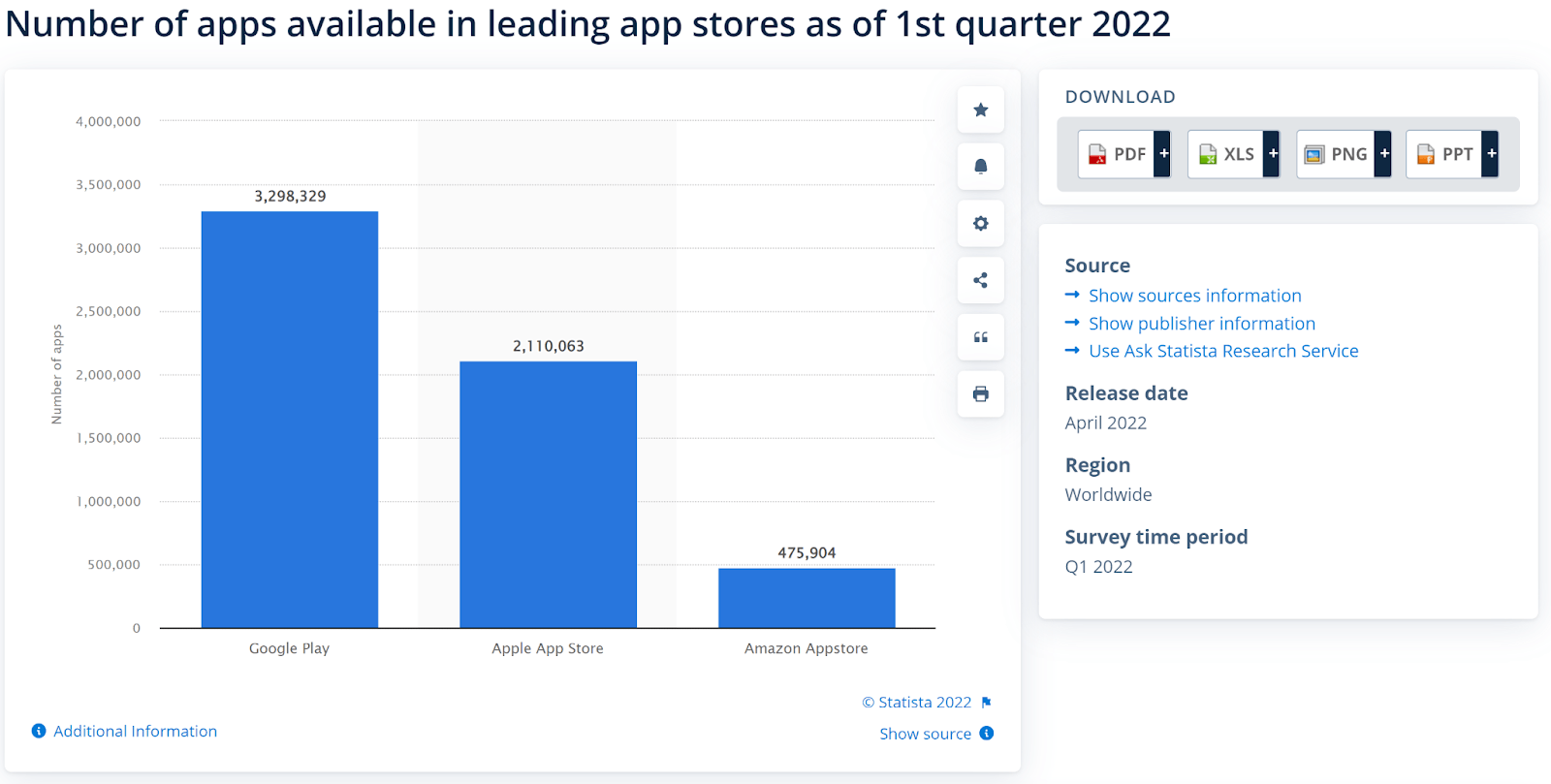Launching your mobile app isn’t enough. You know that building and designing your app are just half of the work. You need to ensure you have strategies in place to support your user acquisition and increase app popularity, and ultimately multiply your revenue. If you are serious about the success of your mobile application, you should create app growth strategies, execute them, and regularly evaluate their performance. Thus, if you are wondering how you can grow your app in 2022, then you need to continue reading this post.
What is an app growth strategy?
Generally speaking, when you say growth strategy, you are talking about specific plans on how to address existing and potential challenges with the aim of expanding or growing a product, business, or company. So, in this case, an app growth strategy involves creating a blueprint or roadmap that aims to grow or expand the reach or influence of a mobile app. Simply put, you want to widen your market share to reach more people and grow your business.
This article was first published on shyftup.com.
5 reasons you should create app growth strategies
Before you go further, it is a must that you know why you should not underestimate the power of app growth strategies. Here are 5 reasons to remember:
Reason no. 1: Overcome competition
According to Statista, there are about 6.6 billion people who use smartphones today. That’s about 85% of the world’s population!
Number of smartphone subscriptions worldwide from 2016 to 2027
Source: Statista
As you can see, the mobile app market is huge and there’s a lot of earning potential in this field. However, do you know what else is huge? Competition. If you are in the mobile app business, you know the massive effort you need to exert simply to get noticed in the world of mobile applications. Get this: in the Apple App Store, there are about 1.96 million mobile apps. On the other hand, there are 2.87 million apps in Google Play Store. If you combine those mind-boggling numbers, you can just imagine the fierce competition that you have to face. No wonder, 90% of mobile apps fall down the cracks of app stores.
Source: Statista
Thankfully, you can be part of the 10% of mobile apps that thrive. And do you know what you need to make that possible? That’s right — you need a mobile app growth strategy.
Reason no. 2: Improve app visibility
Think about this for a second: you spent so much time developing your app. You made sure you have all the essential features. You have tested it multiple times to detect bugs and ensure your app works as intended. You are now ready to launch your app. You push the launch button and you expect people will flock around your newly introduced app. However, minutes passed by and minutes turned to hours and hours to days. All you heard were crickets!
This is a common scenario most mobile app owners experience when they don’t think about how they will market their product. While yes, you may have a few downloads here and there, you just can’t seem to get through the roof and you see slow to no growth. You see, your app can be great, but if people don’t know that it exists, you simply lose all the opportunity to earn. That’s why you need a Google and Apple growth strategy. The better your strategies are, the more people will know about your app. Increased visibility would almost always lead to increased downloads and users.
Reason no. 3: Indentigy ways to improve apps
You can’t possibly create app growth strategies without doing your research. You need to learn who your target audience is, the weakness and strengths of your app, and potential avenues for growth that you can take advantage of. That’s why, when you strategize your app growth, it naturally helps you improve your app. Growing your app means capitalizing on your strength and eliminating or improving your weakness. All these allow you to see the different possible ways to enhance your existing app features, add new useful ones, and address the frustrations of your users.
CTV Growth Guide: A must-read for performance marketers
Whether you’re looking to boost brand awareness or drive user acquisition, this guide has you covered. Learn how to leverage CTV for both brand awareness and performance-driven campaigns and get actionable insights to optimize your strategies.
Download nowReason no. 4: Provide clarity and direction
Helen Keller once said, “The only thing worse than being blind is having sight with no vision.” That may sound cheesy, but that’s actually true if you want to thrive in the mobile app cyberspace.
A lot of mobile app developers don’t have a vision of what they want their app to be. They may have an inkling of what they want, but they don’t know how to get there. An app growth strategy would help you gain clarity of where you want to go and the exact strategies to get you there. That’s the reason why app growth strategies are super important. When you have the right strategies in place, the steps you want to take are clear and you are better positioned to scale up your business.
Reason no. 5: Create more revenues
Obviously, your ultimate goal is to increase your revenue. Unless your mobile app is just a hobby or a non-profit enterprise, you want to ensure that your earnings are higher than your expenses. With app growth strategies, all the positive effects that it brings would translate to more app downloads, app users, and of course, revenue. So, there’s really no reason for you to ignore app growth strategies.
4 apps growth strategies you should consider
There’s no doubt that app growth strategies are important for the success of your app. The next question now is, “How do you create app growth strategies?”
Here are four of the most effective ways you:
App development
First off, when it comes to app growth strategies, you can focus first on your app and develop it further. Now, product development can involve developing your existing apps or creating new ones. To develop existing apps, you can add new features, remove needless features, or create new services. Product development also involves creating new apps with the aim to solve existing problems or provide new features that are not yet available in the market. In summary, here are some ways product development is done:
- Investing in research
- Develop new apps
- Buy someone else’s app
- Rebranding your app or a newly acquired app from others
- Joint app development with other companies
App market development
You look at your current market and look for new ways on how you can further take advantage of it. Sometimes, through research and study, you find new segments of your existing market that you haven’t explored yet. Aside from developing the existing markets, you also do a market expansion. You identify new segments of users you haven’t thought of selling to before. To do market development, you can consider the following:
- Create systematic and well-defined customer segments
- Identify potential users
- Discover new ways to approach or sell to existing users
App market penetration
Sometimes, market development and market penetration can be confusing. However, the main difference between the two is that market penetration is focused more on increasing the profits of existing apps in an existing market.
On the other hand, app market development is more focused on developing new apps and giving them to an existing market. To perform app market penetration, you can do the following:
- Aim to acquire new users from competitors
- Drive more sales from existing users
- Persuade more existing users to perform desired actions
- Decrease the price of your app to attract more users
- Perform more marketing promotion
- Buy competitors’ apps
App diversification
Among the four app growth strategies mentioned here, app diversification is perhaps the riskiest one. As this might be the case, if done correctly, app diversification can give you the highest return on investment. App diversification is simply the launching or creation of new apps for a new market. Since a major part of app diversification is new and could be unchartered territory for app owners, you need to do a lot of research before you fully dive in. To perform app diversification, you can buy or develop new apps that are completely unrelated to your existing apps.
What is the best growth strategy?
The best growth strategy is the one that best fits your needs, preference, situation, and of course, budget. There’s really no specific answer to this as every app comes with its unique circumstance. Sometimes, the best growth strategy is a combination of two or more strategies.
To determine the right expansion strategy for your app, you need to do market research, assess your current situation, and study your customers.
How to create a mobile app growth strategy?
There’s no one-size-fits-all method when it comes to strategizing your app growth. One method can be great for one app but it’s not as great for another. Thus, it’s a must that you take time to understand your unique situation and determine how you can best come up with the right mobile app growth strategies. While the process of creating an app development strategy can be different from one app to another, here are 10 general steps that are involved.
Step 1: Determine what makes your app unique
The value proposition is the very thing that will attract your users to your app. You need to make sure that you have something that is different from what other apps can offer. If not, you won’t stand out. Plus, you won’t be able to give enough reasons for users to switch to your app from your competitors. You need to ask yourself:
- What makes your app different?
- What can your app offer that your competitors can’t offer?
- What makes your app relevant?
It’s important that you know your app’s value proposition. Without it, growing your business would be an uphill battle.
Step 2: Identity your users
You need to face the fact that you can’t serve everyone. Every user has a unique set of needs, preferences, and budgets. Thus, you must focus on the users that you can serve best. When identifying your target audience, you must be specific. If not, you will end up spreading yourself too thin or spending your resources on things that don’t really matter. You need to ask yourself:
- Who are the people that I want to use my app with?
- What are their gender, age, place of residence, hobbies, and likes?
- What are the potential and existing problems of my users?
If you don’t have a customer base yet, you can study your competitors and the users they are serving. That should give you an idea of who you will need to target. If you already have app users, identify the ones that benefit you the most. You can focus on them and find more people with the same characteristics to maximize your profit. In the future, you can then expand and find new customer segments that you can target.
Step 3: Check your profit
Once you have cash coming in, you need to study where they are coming from and the nature of your source of profit. Sometimes, there are revenue streams from your app that don’t really make much. You can either improve or eliminate them to save energy and resources. You can also capitalize on your main source of income. See how you can make it more profitable and create more opportunities to earn.
Step 4: Study your competition
Sun Tzu, a great military strategist, once said, “Know your enemy.” That’s one piece of advice that is useful in creating app growth strategies. Competition is similar in wars in many ways. If you want to come out victorious, you must know who you are dealing with.
Thus, the next step you need to take is to know your competitors. Identify their strengths and emulate them. Check where they may be lacking and see how you can fill the gap.
Step 5: Determine where you want to grow
There are different aspects of your app that you can actually scale up. Hence, you must specifically identify in which area you want to grow. Here are some of the areas of growth you may want to consider:
- Profits
- Number of employees
- App stores
- App features
- New app development
- Marketing
Step 6: Perform market research
The last thing you want to happen is to spend so much time and energy executing your app growth strategy and ending up with no to few results. Consequently, you must conduct market research. Part of your market research is knowing who your target audience is and what particular problems or needs your app can meet. Market research unlocks your understanding of how you can grow your business through your app. Along with this understanding, you’ll also learn how to create specific strategies to ensure you meet your goals.
Step 7: Set objectives and goals
Now that you know where you are, it’s time to know where you want to be. That’s where goals come in. With app growth strategies, you need to set short-term and long-term goals.
Be sure that your goals are specific, measurable, time-bound, achievable, and realistic. Yes, you can set ambitious goals, but just be sure that you’re not setting yourself up for failure. Market research can dramatically help you in setting your goals.
Step 8: Create a concrete plan
It’s good to have goals, but you must know how to achieve them. Build specific systems and plans that will move you closer to your goal. From budgeting to planning, from execution to evaluation, you need to have all things lined up. It is not enough to just imagine what you want to do. You must put it into writing so that you can clearly know what action to take, when to do it, and how to do it.
Step 9: Form a team
If you want to achieve more, you need to form a team. Of course, you need to have a team with the right people. Increasing the number of your employees multiplies your output. It helps you do more in a shorter period of time.
If you really want to scale up or expand your business, you can’t do it on your own. No big companies become big by just having one employee. So, hire an app developer, app store marketer, SEO writer, website engineer, or any qualified professional with the right talent to build your team.
Step 10: Check requirements for growth
For your app to grow, you need to lay down the right foundation. You can’t expect your app to exponentially grow if it is riddled with issues, bugs, and outages. Before you can look for more users or expand to new markets, you must check the health of your app. You also need to understand the current situation of your mobile application. For example, if you have launched your app and you don’t see any growth for the last few months, you must first identify the underlying cause of your problem. If you are too focused on user acquisition while letting app issues go amok, then you will not retain users. They will simply download your app and eventually uninstall it in just a few days or hours. Aside from ensuring your app is set for growth, there are other things you might need to scale up your business. Here are some of them:
- Funding – money is a huge factor that determines how much you can and are willing to spend when it comes to expanding your app’s reach and capabilities.
- Employees – as mentioned above, the size of your team is usually directly proportional to your output. Generally, the more people you have, the more you can do. This gives way to exponential app growth.
- Technology – there are tools, pieces of software, and technologies that can help you grow your app. For example, you might need additional laptops and faster internet speed to facilitate the growth of your app.
- Services – growing your app doesn’t mean that you have to do it all alone. You can always hire third-party service providers to help you in doing your work. One good example would be your market research. There are services available today that help you gather and analyze data.
How do mobile apps grow users?
Mobile apps can only grow their customer or user base by ensuring they offer what their users need and want. There are a lot of factors that come into the growth of users. When you consider all of them and know how to nourish your users based on those factors, you should be able to support your app growth. Here are a few factors you need to address:
- Core features, functionalities, and usefulness
- User-friendliness
- App speed
- Focused on users
- Customizability
- Customer support
- Uptime
When you ensure that users are satisfied with all these factors, then your app will eventually increase its users.
What is the cost of creating growth strategies?
The cost of growing your business depends on how much you want to expand your app. Cost may range from a few hundred dollars to a thousand dollars. Sometimes, there are also strategies you can do that virtually won’t cost you anything but time. Moreover, you also need to consider both your short-term and long-term expenses. Many growth strategies take months and even years to produce results. Be sure you are able to sustain it.
How real companies used app growth strategies
To better understand how growth strategies work in mobile apps, you may want to see some examples. Here are some of the most popular apps today and how they worked their way to the top.
Facebook is no doubt one of the most popular and biggest social media sites today. For it to become what it is now, it used the diversification strategy. Facebook acquired potential rivals. In fact, according to some estimates, it has already acquired more than 90 companies to date. Here are some popular companies Facebook bought:
- Oculus VR
- Onavo
- Beluga (later discontinued and created the Facebook Messenger)
Instagram is a photo and video-sharing app that became one of the most downloaded apps in recent years. This might not be possible if they didn’t use app development strategies. Instagram positioned itself to be a great app for mobile devices. They did this by creating an app that is specially designed for smartphones. In fact, at the time of this writing, you still need to use the app to upload photos and videos. You can’t do it on your computers unless you have special browsers. Instead of becoming a mediocre application for both desktop and mobile, Instagram focused its energy on making its app super useful on mobile. They developed an app that is mainly for smartphones and tablets. Although users are limited to fully using Instagram on their phones, they are still happy to use Instagram because of how sleek and well-designed the app is.
TikTok
One good example of how to perform market penetration for app growth is TikTok. Since the start of the pandemic, TikTok rose in popularity with over 2 billion downloads at the time of this writing. So, how did TikTok manage to become massively popular? They ensure that more and more people would know about their app. By aggressive advertising, they were able to get an unimaginable number of users. TikTok sent its ads to every place where young people hang out. Not only that, but TikTok didn’t shy away from displaying its ads on rival social sites such as Facebook, Snapchat, and YouTube. The smart branding and marketing campaign of TikTok penetrated its target market so deeply that they were able to amass billions of users.
Did you know that WhatsApp was created in Mountain View, California? It’s a US-based app with over 2 billion users. However, you might think that its users, or at least the majority of its users, would be in the US, but no. WhatsApp is most popular outside of the US and its billions of users are scattered across over 180 countries. How did WhatsApp achieve this? They used smart market development. By nourishing its existing userbase and expanding its market internationally, WhatsApp saw an astronomical rise in its popularity.
Developer your app growth strategy today
App growth strategies are essential to the success of mobile apps today. With fierce competition, complicated data to analyze, and too many unknown and known factors to consider, you are left wondering what to do next. In this post, you have just read what app growth strategy is all about, why it is important, and how it works. The challenging part is how you can apply what you just learned. That’s where we come in. At ShyftUp, we have the right knowledge, tools, and experience to grow your user base exponentially. We ensure that your app grows together with your business. Contact us today and discover how we can work together to bring your app to the next level.














